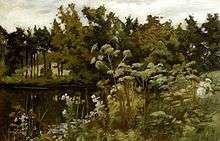Shrubbery
A shrubbery is a wide border to a garden where shrubs are thickly planted, or a similar larger area with a path winding through it. A singular shrub is also known as a bush.[1]

Characteristics
A shrubbery was a feature of 19th-century gardens in the English manner, with its origins in the gardenesque style[2] of the early part of the century. A shrubbery[3] was a collection of hardy shrubs, quite distinct from a flower garden, which was a cutting garden to supply flowers in the house. The shrubbery was arranged as a walk, ideally a winding one, that made a circuit that brought the walker back to the terrace of the house. Its paths were gravel, so that they dried quickly after a rain. A walk in the shrubbery offered a chance for a private conversation, and a winding walk among shrubs surrounding even quite a small lawn was a feature of the garden behind a well-furnished Regency suburban villa.
"Mr Rushworth," said Lady Bertram, "if I were you, I would have a very pretty shrubbery. One likes to get out into a shrubbery in fine weather." —Jane Austen, Mansfield Park (1814).
Structural components
In the 1980s John Nash's never-executed plans for the garden setting of the Brighton Pavilion, illustrated in Nash's volume Views of the Royal Pavilion (1826), were finally carried out in connection with the extensive restorations of the Pavilion itself.[4] Its "fairly open landscape of soft lawns dotted with trees and set with lightly-wooded, sinuous shrubberies" are best illustrated in Augustus Charles Pugin's[5] watercolor view c. 1822 of the west front of the Pavilion,[6] reproduced in Nash's publication. The winding perimeter walk circling the lawn among the shrubs and trees, enriched with island beds of herbaceous perennials, began to be laid out in 1814, with a flush of activity 1817-21. Two books of commentaries proved indispensable for the replanting scheme. One was Henry Phillips, who wrote in 1823
The shrubbery is a style of pleasure-garden which seems to owe its creation to the idea that our sublime poet formed of Eden. It originated in England and is as peculiar to the British nation as landscape planting.[7]
The formulas for arranging a shrubbery were founded on contemporary painterly requirements for the Picturesque; judicious contrast and variety were essential, but Philips seems to have been among the first garden writers to notice that yellowish-green leaves in the foreground seem to throw bluish green-leaved shrubs deeper into a perceived distance.[8] The desirable undulations of paths and islands and bands of shrub plantings would ideally undulate in elevation too: "break up the level by throwing up elevations,' Philips suggested, "so as to answer the double purpose of obscuring private walks and screening other parts from the wind."[9]
Nash was at work also on the public parks of London, devising the shrubberies of Regent's Park and of St. James's Park, where the German visitor Prince Pückler-Muskau discerned that
Mr Nash ... masses the shrubs more closely together, allows the grass to disappear in wide sweeps under the plants or lets it run along the edges of the shrubs without trimming them ... hence they soon develop into a thicket that gracefully bends over the lawn without showing anywhere a sharply defined outline[10]
Such precise effects were made immeasurably simpler by the invention in 1827 by the English engineer Edwin Beard Budding of the rotary lawn mower, an extrapolation of machinery commonly used to cut velvet pile.
After the turn of the new century Gertrude Jekyll offered a chapter of suggestions for "Wood and Shrubbery Edges" in Colour Schemes for the Flower Garden (London, 1908) in which her descriptions were based on her own garden at Munstead Wood, south of Godalming, Surrey, but her shrubbery and hardy perennial plantings were designed to soften transitions: "Where woodland joins garden ground there is often a sudden jolt; the wood ends with a hard line, sometimes with a path along it, accentuating the defect."[11] In the expansive space of even a small Edwardian garden, Miss Jekyll recommended a space "from twenty-five to forty feet" planted so as to bring wood and garden into harmony, "so planted as to belong equally to garden and wood." Rhododendrons were the stand-by in these shrub belts, combined with ferns, wood-rush, lilies, white foxgloves and white columbines.
Notes
- American Heritage Dictionary. Houghton Mifflin.
- John Warfield Simpson, Visions of Paradise: Glimpses of Our Landscape's Legacy 1999:297.
- Elizabeth Kent, Sylvan Sketches Or A Companion To The Park And The Shrubbery With Illustrations From The Works Of The Poets, (London) 1831.
- Virginia Hinze, "The Re-Creation of John Nash's Regency Gardens at the Royal Pavilion, Brighton" Garden History 24.1 (Summer 1996:45-53).
- Father of the better-known designer and architect Augustus Welby Northmore Pugin.
- Hinze 1996:46, fig. 1.
- Philips, Sylva florifera. The Shrubbery, Historically and Botanically treated, with observations on the formation of Ornamental and Picturesque Scenery (London, 1823), quoted in Hinze 1996:49.
- Philips 1823:23, noted by Hinze.
- Philips 1823: I.20, quoted in Hinze 1996:51.
- Pückler-Muskau, (S. Parsons, ed.) Hints on Landscape Gardening (Boston, 1971:71-72), noted by Hinze.
- Jekyll 1908:92.